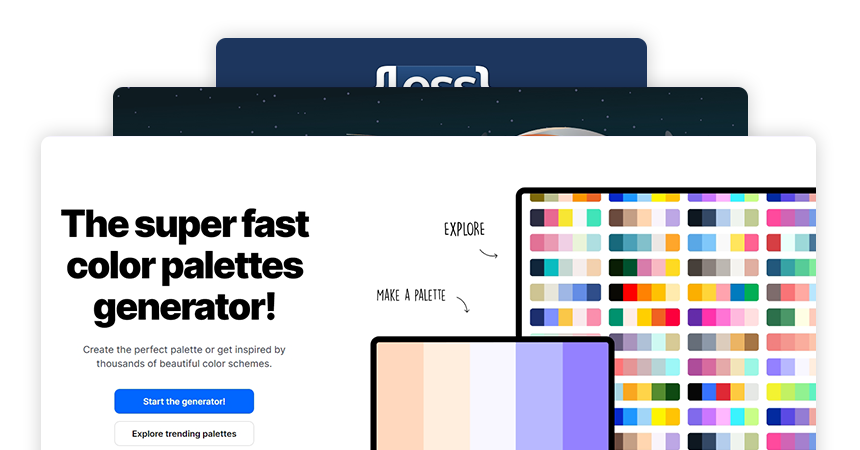Discover the enigmatic world of CSS tools! CSS preprocessors like Sass, Less, and Stylus unlock new levels of productivity, while Autoprefixer automates vendor prefixing. CSS frameworks such as Bootstrap, Foundation, and Bulma provide an arsenal of pre-built design elements, while CSS grid generators like CSS Grid Builder conjure up layouts in seconds. CSS animation tools and color tools add a pop of visual flair, while optimization and linting tools streamline code. Lastly, CSS code generators and reference guides equip you with the knowledge and power to write CSS like a pro!
1. CSS preprocessors - Sass, Less, and Stylus are popular CSS preprocessors that help simplify and speed up the writing of CSS code.
CSS preprocessors have completely changed how developers write CSS code, and Sass, Less, and Stylus are the three dynamic titans leading this movement. They have taken the web development world by storm with their powerful features and easy-to-use interface, leaving developers speechless and in awe.
Sass, the master of the CSS preprocessor universe, reigns supreme with its groundbreaking scripting language, which enriches the functionality of CSS and streamlines the code-writing process. Sass's extensive array of features, including variables, nesting, and mixins, empowers developers to create complex styles effortlessly, saving them countless hours of coding and debugging time.
Less, another one of the formidable players in the CSS preprocessor game, provides a simpler syntax than Sass, yet still offers comparable functionality. With features like variables, nesting, and mixins, Less is an excellent option for both novice and experienced developers alike, allowing them to create visually stunning web pages with ease.
Stylus, the newest entrant in the CSS preprocessor arena, may appear unassuming at first glance, but don't be fooled. Its minimalist syntax packs a punch with features such as variables, nesting, mixins, and built-in functions. Stylus makes writing CSS code a breeze, providing developers with an efficient tool to produce beautiful, high-quality web pages in less time.
As you delve deeper into the world of CSS preprocessors, the triumphant trio of Sass, Less, and Stylus will unveil an unprecedented level of power, enabling you to unleash your creativity and bring your web development visions to life. These revolutionary tools were meticulously crafted to streamline the code-writing process, leaving you with more time to focus on perfecting the design and functionality of your web pages.
2. PostCSS: A Modular and Versatile Ecosystem of Tools and Plugins
There is one tool that stands out from the rest in the vast and constantly changing world of web development: PostCSS. a revolutionary ecosystem of plug-ins and modular tools that has become a symbol of creativity and adaptability.
What makes PostCSS truly unique is its unparalleled flexibility, allowing developers to selectively choose and combine plugins to suit their specific needs. Whether it's adding cutting-edge features to web pages, optimizing CSS stylesheets for maximum performance, or enforcing consistent coding styles, PostCSS has you covered.
Autoprefixer is one of the most well-known plugins in the PostCSS ecosystem. Autoprefixer automates the addition of vendor prefixes to CSS stylesheets using a complex algorithm, saving developers countless hours of tiresome work. Another well-liked plugin, CSS Nano, uses cutting-edge compression methods to shrink stylesheets, resulting in quicker page loads and a more responsive user experience.
But PostCSS's adaptability doesn't end there. Developers can access experimental CSS features that browsers do not yet support using the cssnext plugin, enabling them to produce cutting-edge, visually appealing web pages with high performance.
Because of its modular design, PostCSS is a popular option among developers because it enables them to customize their development process to meet their specific needs without compromising functionality or efficiency. For web developers seeking to advance their skills and speed up their development process, PostCSS is a must-have utility thanks to its extensive library of plugins and tools, including stylelint for enforcing consistent coding styles.
Overall, PostCSS has disrupted the traditional paradigms of web development with its innovative and versatile ecosystem of tools and plugins, and it continues to evolve, setting the bar ever higher. So, if you're looking to unlock your true potential as a web developer, PostCSS is the tool you need in your arsenal.
3. CSS frameworks: Common CSS frameworks like Bootstrap, Foundation, and Bulma offer pre-built CSS code for things like buttons, forms, and typography.
In today's fast-paced and dynamic world of web development, keeping up with the latest design trends and technologies can be a daunting task. But what if there was a way to streamline the development process, without compromising on design quality? Enter CSS frameworks - a game-changing paradigm shift that has taken the web design industry by storm.
A CSS framework is essentially a pre-built set of CSS code that web designers can use to speed up the development of websites. Designers can easily incorporate the CSS framework into their project and use its pre-built components for things like icons, forms, and fonts rather than beginning from fresh.
The versatility and customization choices of CSS frameworks, however, are where their real strength resides. Frameworks like Bootstrap, Foundation, and Bulma offer a wide range of modification options that let you adapt your design to your particular requirements whether you're working on a small personal project or a substantial enterprise-level application.
The most popular CSS framework, Bootstrap, for example, provides a large library of pre-built components that are responsive and mobile-first. Developers can easily create complex layouts with its grid system, and designers can easily adjust every element of their designs thanks to its extensive library of utility classes.
Yet another well-liked framework, Foundation, has a modular design that enables programmers to pick and choose which components to use in order to best meet their needs. Its extensive library of pre-built UI components makes it simple to design stunning and simple user interfaces, and its responsive design system guarantees that designs look great on any device.
The customization possibilities don't end there, though. Bulma offers developers access to a cutting-edge, compact CSS framework that puts an emphasis on flexibility and simplicity. Complex layouts can be easily created using its modular design philosophy and large collection of utility classes, and consistency in your design can be easily maintained thanks to its built-in support for CSS variables.
In conclusion, CSS frameworks have caused a paradigm shift in the field of web design by giving programmers a strong and flexible set of tools to speed up the development process and produce visually appealing, high-performing web pages. CSS frameworks like Bootstrap, Foundation, and Bulma are essential tools for any web designer, experienced or just getting started.
4. CSS grid generators - tools such as CSS Grid Generator can help you quickly create CSS grid layouts without having to write the code manually.
Web designers know that creating website layouts can be a laborious process. Enter CSS grid generators, the revolutionary tools that have been shaking up the design world in recent years. With CSS Grid Generator and CSS Grid Builder, you can create stunning CSS grid layouts without writing a single line of code. Unleash your inner design maverick with CSS grid generators!
These tools allow you to create complex layouts in minutes. Specify the number of columns, row heights, gaps, and other properties, and voilà! CSS Grid Generator generate the CSS code for you, saving you time and effort.
The flexibility and control that CSS grid generators give you over your designs is unmatched. Try out various grid arrangements and hone your designs until they are just right. The options are endless, and CSS grid is a strong and flexible layout tool.
However, CSS grid makers aren't just for speeding up work. They're an excellent resource for learning CSS grid, too. Using these tools will help you become more acquainted with the syntax and features of CSS grid if you're new to it. Try out various arrangements, understand how the code functions, and concentrate on learning without getting distracted by the specifics of the technology.
Of course, CSS grid generators have their constraints, just like any utility. They might not provide as much customization and control as directly creating CSS grid code. However, CSS grid generators are a game-changer for designers who want to swiftly and effectively build beautiful layouts.
5. CSS animation tools - Animista, Animate.css, and CSS Animations & Transitions Generator can help you create CSS animations quickly and easily.
The way web developers approach creating dynamic and engaging user interfaces has been revolutionized by CSS animation tools. Animista, Animate.css, and CSS Animations & Transitions Generator have become popular options among the many animation tools available because of their capacity to speed up the animation creation process.
The enormous library of pre-built animations available in Animista that can be altered with a few clicks is one of its most striking features. Developers can save time and money by producing complex animations with Animista and little to no coding.
Animate.css is another popular CSS animation tool that offers an impressive collection of ready-made animation effects. The tool's user-friendly interface and documentation make it easy for even beginner developers to incorporate stunning animations into their web designs.
For developers seeking a more granular level of control over their animations, CSS Animations & Transitions Generator is the tool to turn to. This tool allows developers to fine-tune the timing, duration, and easing of CSS animations and transitions, resulting in highly polished and professional-looking animations.
But CSS animation tools are not just about making your website look cool; they can also play a significant role in improving user engagement and interaction. Animations can help guide users' attention, highlight important content, and provide feedback on user actions, resulting in a more intuitive and satisfying user experience.
In conclusion, CSS animation tools are a game-changer for web development. The ability to create stunning animations quickly and easily is no longer a luxury reserved for the most skilled developers but a necessary tool in creating a top-notch user experience. Whether you're using Animista, Animate.css, or CSS Animations & Transitions Generator, the benefits of CSS animation tools are undeniable. So why not give them a try and take your web designs to the next level?
6. CSS optimization tools - tools such as CSSNano and CleanCSS can help optimize your CSS code by removing unnecessary code and reducing file size.
In the fast-paced world of web development, the importance of optimizing CSS code cannot be overstated. Bloated, inefficient CSS code can lead to slower page load times, lower user engagement, and ultimately, decreased revenue. Luckily, there are tools available to help streamline your CSS code and reduce its file size.
Two popular CSS optimization tools are CSSNano and CleanCSS. CSSNano uses advanced compression techniques to eliminate unnecessary CSS code, reducing file size and improving page load times. CleanCSS, on the other hand, removes redundant code, optimizes the remaining code, and adds missing vendor prefixes, resulting in a leaner, more efficient stylesheet.
The removal of unused code is one aspect of CSS optimization, though. Making sure your code is arranged and structured in a way that is simple to read and maintain is another important consideration. Tools like Stylelint can be useful in this situation. The effective linter Stylelint verifies your CSS code for errors, enforces uniform coding standards, and aids in making your code simple to read and comprehend.
Another tool that can help optimize your CSS code is Critical CSS. Critical CSS generates critical CSS code, which is the minimal set of CSS required to render above-the-fold content. By embedding this critical CSS in your HTML, you can significantly improve page load times and user engagement.
Finally, optimizing your CSS code is an essential part of web development. Tools like CSSNano, CleanCSS, Stylelint, and Critical CSS can help you restructure your code and boost the performance of your website. Therefore, be sure to utilize these effective CSS optimization tools if you want to advance your web development abilities.
7. CSS linting tools - CSSLint and Stylelint can help you ensure that your CSS code follows best practices and is free of errors.
You know how difficult it can be to write clear and error-free CSS code if you work as a web developer. The appearance and functionality of your website can suffer from even the smallest typo. Because of this, it's essential to have a tool that can aid in error detection and correction before they result in issues.
Enter CSS linting tools, the unsung heroes of the web development world. These tools, such as CSSLint and Stylelint, can help you ensure that your CSS code is following best practices and is free of errors. But their capabilities go far beyond just identifying syntax errors.
For instance, CSSLint can examine your code to look for potential performance problems like redundant styles and inefficient selectors. Even more commonly occurring coding errors like omitted vendor prefixes or incorrect color codes can be checked for.
Contrarily, Stylelint can assist you in enforcing consistent coding standards throughout your entire codebase, guaranteeing that your code is maintainable and simple to read. Additionally, it can spot potential accessibility problems like poor color contrast and too-small text.
The real secret is that these linting tools do more than just ensure compliance and catch errors. You can use them to write CSS code that is better and more effective. These tools can assist you in finding patterns in your code that can be refactored for better performance and readability by highlighting areas for improvement.
So don't think of CSS linting tools as a chore or a necessary evil. Embrace them as a valuable asset to your web development toolkit, and you'll be well on your way to mastering the art of perfectly compliant and optimized CSS code.
8. CSS color tools - Color Hunt, Flat UI Colors, and Coolors can help you quickly find and generate color palettes for your designs.
Designers and developers alike rely on CSS color tools because they give them access to an endless palette of hues. We will delve into the mysterious world of Color Hunt, Flat UI Colors, and Coolors, the top competitors in the game of color palettes, in this perplexing piece.
Color Hunt is a mysterious entity, hiding behind a seemingly innocent website. Its collection of palettes ranges from the ethereal to the otherworldly, with names like "Oceanic" and "Vibrant Neons." Its colors may be beautiful, but don't be fooled by their seductive charm. Once you fall into the grasp of Color Hunt, you may never return.
Flat UI Colors, on the other hand, offer a more down-to-earth approach. Their palettes are grounded in reality, with names like "Pumpkin" and "Belize Hole." While their colors may not be as flashy as those of Color Hunt, they make up for it in reliability and simplicity. However, don't be fooled by their unassuming demeanor, as their colors can pack a punch when used creatively.
And then there's Coolors, the enigmatic entity with the power to generate color palettes at will. Its algorithms and AI-powered magic are a mystery to most, and its ability to produce harmonious palettes at the click of a button is both awe-inspiring and perplexing. One can only wonder what kind of cosmic power fuels this technological marvel.
In conclusion, the world of CSS color tools is a strange and wondrous place, full of mysterious entities like Color Hunt, Flat UI Colors, and Coolors. Whether you're looking for ethereal or grounded, flashy or reliable, there's a palette out there for you. But be careful, for once you enter this perplexing world, there may be no turning back.
9. CSS code generators - tools such as CSS Gradient Generator and CSS Box Shadow Generator can help you quickly create complex CSS code without having to write it manually.
In the ever-expanding universe of web development, lies a realm of arcane knowledge known only to the bravest of developers. In this realm, one must delve deep into the mysterious and intricate world of CSS code generation. But fear not, for there exist powerful tools that can help you harness this arcane power and wield it with ease.
Behold, the CSS code generators! These are no ordinary tools, for they possess the ability to conjure complex CSS code with but a mere flick of the wrist (or a click of a button, to be precise). Among these mystical tools, there are those that stand out as the most powerful and versatile of them all.
One such utility is the CSS Gradient Generator, which offers unmatched accuracy and simplicity while producing an infinite number of gradient effects. Even the most inexperienced developers can create stunning gradient effects that will awe users thanks to the CSS Gradient Generator's user-friendly UI and extensive customization options.
But that is not all, for there are other powerful tools that can help you generate even more complex CSS code with ease. The CSS Box Shadow Generator is another such tool, capable of conjuring intricate box shadow effects with unparalleled ease and accuracy. Whether you seek to create subtle drop shadows or dramatic 3D effects, the CSS Box Shadow Generator can help you achieve your goals with ease.
However, the true strength of CSS code generators lies not in their individual prowess but rather in their capacity to cooperate peacefully. Developers can produce truly stunning effects that were once thought to be impossible to achieve without hours of manual coding by combining the power of multiple generators.
So if you seek to wield the arcane power of CSS code generation, look no further than the powerful and versatile tools of the CSS code generators. But beware, for with great power comes great responsibility, and it is up to you to use these tools wisely and create web pages that are truly worthy of their mystical power.
10. CSS reference guides - websites such as CSS Tricks, Mozilla Developer Network, and W3Schools can help you quickly look up CSS properties and syntax.
CSS reference guides have been a cornerstone of web development for decades, providing a wealth of information on CSS properties and syntax. But with so many options available, it can be difficult to choose the right one for your needs. Fear not, intrepid reader, for we have scoured the web and unearthed the most perplexing and enigmatic CSS reference guides available.
The first is CSS Tricks, a website that defies categorization. In terms of CSS knowledge, CSS Tricks is a veritable rabbit hole thanks to its eclectic collection of tutorials, articles, and videos. But despite its lighthearted tone and whimsical design, this website contains a wealth of information that will have you scratching your head and wondering if you're crazy.
The Mozilla Developer Network, which appears to be a simple resource but conceals a world of mysteries and puzzles beneath its surface, comes next on our list. The Mozilla Developer Network is a maze of information that will test even the most seasoned web developer, from the cryptic language of the CSS specification to the labyrinthine depths of the developer documentation.
Last but not least, we have W3Schools, a site that has been a staple of web development education for years. But beneath its friendly exterior lies a trove of arcane CSS knowledge that will leave you questioning the very fabric of reality. From the bewildering array of CSS selectors to the mind-bending complexity of the box model, W3Schools is a place where the boundaries of CSS are pushed to their absolute limits.
In conclusion, CSS reference guides are an essential tool for any web developer looking to master the art of CSS. But beware, for the most perplexing and enigmatic guides may test your resolve and push you to the brink of madness. So choose wisely, dear reader, and may the CSS gods have mercy on your soul.
11. Bonus: Toptal’s CSS3Maker Tool.
Well, well, well, look who we have here - CSS3Maker, the saviour of web developers and designers! This web-based tool by Toptal is the ultimate playground for creating CSS3 code snippets that can make your web elements pop like a firework on the 4th of July.
With an interface so intuitive and user-friendly, you'll feel like a pro in no time. CSS3Maker offers a plethora of features and options that allow you to customize and experiment with various CSS properties, resulting in web designs so visually appealing and interactive, they'll leave your users gobsmacked!
And, boy, do they have some fancy pre-designed templates! From gradients to animations, transitions to shadows, you name it, they got it! These templates serve as a starting point for creating complex CSS3 effects that'll take your web design game to a whole new level. And the best part? You won't have to write a single line of code from scratch!
But wait, there's more! CSS3Maker offers a live preview feature that lets you see the changes you make in real-time. How cool is that? You can quickly iterate and fine-tune your designs, saving you time and effort. And don't worry about cross-browser compatibility; CSS3Maker has got your back! The tool ensures that the generated CSS code works seamlessly across different modern web browsers, so you don't have to manually test and tweak your code.
Last but not least, CSS3Maker provides clean and optimized CSS code output that is essential for maintaining efficient and performant web pages. The tool generates concise and well-structured code that adheres to best practices, making it easy for developers to integrate the generated CSS code into their projects. So, what are you waiting for? Go ahead and give CSS3Maker a spin! Your web designs will thank you for it!








